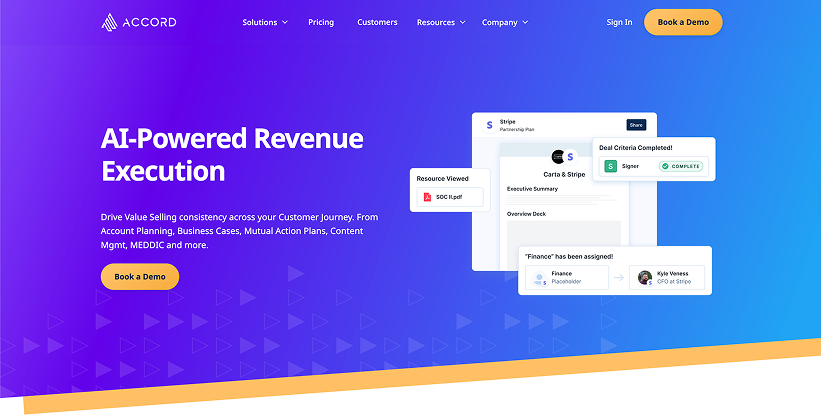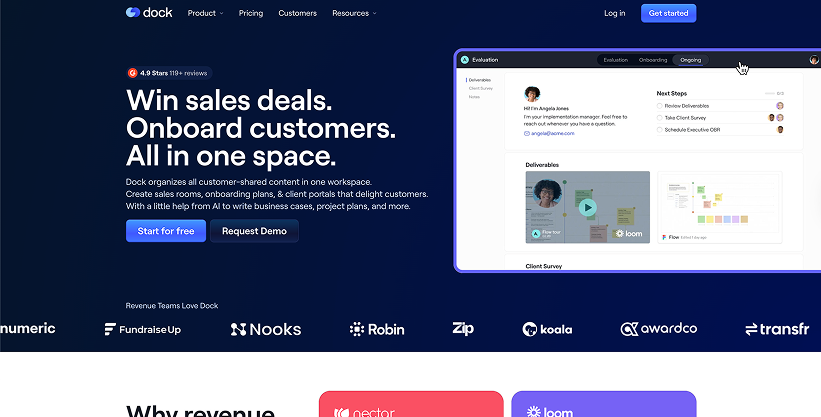Top Slack-Integrated Sales Tools for 2025: The Complete Buyer’s Guide for RevOps and GTM Leaders
Why Slack-Integrated Sales Tools Are Now Business-Critical
Sales execution today happens in real time and it’s happening in Slack. From deal desk approvals and pipeline reviews to customer escalations and onboarding workflows, modern GTM teams are running mission-critical moments inside Slack channels.
What’s changed? The rise of cloud-based collaboration, tighter integration across CRM systems like Salesforce and HubSpot, and the explosion of AI-powered automation tools that surface alerts, schedule meetings, and trigger actions the moment something changes in your pipeline.
If your sales tools don’t integrate with Slack, your reps miss crucial updates. If they don’t post real-time notifications, RevOps misses risk signals. If they don’t automate repetitive tasks, your pipeline suffers.
In 2025, Slack integration is a strategic advantage that determines how fast, coordinated, and data-driven your sales process can be.
This guide breaks down the top Slack-connected sales tools and shows how to pick the right platform to streamline workflows, deliver real-time updates, and boost productivity across your entire GTM org.
What Is a Slack-Integrated Sales Tool?
At its core, a Slack-integrated sales tool connects core sales systems — like CRMs, sales engagement platforms, forecasting tools, or analytics engines — directly into Slack channels where your team is already working.
But the category has evolved beyond simple slack notifications. In 2025, the best Slack-integrated tools offer:
[blue-section]
- Automated workflows triggered by CRM events or deal stages
- Real-time dashboards and summaries delivered via Slack messages
- Bidirectional actions (e.g., approve a discount, flag churn risk)
- AI-powered summaries of calls or meetings, surfaced in relevant channels
- Intelligent routing of tasks to the right team members at the right time
[/blue-section]
Static updates won’t move deals forward. What matters is enabling your team to collaborate and take action where momentum happens in Slack.
Common Challenges Without Strong Slack Integration
Even high-performing GTM teams face friction without integrated workflows between sales systems and Slack. Here’s what breaks:
[number-block number="1"]
Missed Follow-Ups
Without real-time notifications, reps forget follow-ups, managers miss renewals, and no one’s alerted when an opportunity goes dark.
[/number-block]
[number-block number="2"]
Manual Status Chasing
Repetitive tasks like pinging reps for updates or reviewing deal notes delay critical approvals or resource alignment.
[/number-block]
[number-block number="3"]
Scattered Data
Insights from Zoom, Google Calendar, email campaigns, or CRM updates stay locked in silos, forcing RevOps to manually compile reports.
[/number-block]
[number-block number="4"]
Pipeline Blind Spots
When pipeline risks aren’t flagged in Slack channels, leaders lose visibility into what’s slipping—until it’s too late.
[/number-block]
[number-block number="5"]
Tool Fatigue
Juggling Asana, ClickUp, Dropox, or project management tools in parallel adds friction, especially for remote teams trying to stay aligned.
[/number-block]
What to Look for in Slack-Connected Sales Tools
Not all Slack integrations are the same. Here are the key features to prioritize in 2025:
1. Automated Workflows
What it should do: Let you trigger actions (approvals, escalations, follow-ups) based on CRM events or pipeline signals without leaving Slack.
----------
Why it matters: Streamlines decision-making, speeds up sales cycles, and enforces process adherence in a workspace your team already lives in.
----------
What to avoid: Static bots that flood channels without filters or context.
2. Real-Time Notifications
What it should do: Instantly alert teams of changes: deal stage shifts, forecast adjustments, customer interactions, or marketing outreach engagement.
----------
Why it matters: Helps sales reps and managers act fast, especially in high-velocity GTM environments.
----------
What to avoid: Tools that delay updates or batch notifications after-the-fact.
3. CRM Integration
What it should do: Seamlessly push and pull data from Salesforce, HubSpot, and other CRM systems into Slack. Allow updates or approvals directly from the Slack app.
----------
Why it matters: Reduces data entry, unifies systems, and ensures Slack reflects the latest pipeline reality.
----------
What to avoid: Partial integrations that only work for one CRM or lack bi-directional sync.
4. AI-Powered Summaries
What it should do: Automatically summarize customer calls, emails, or Slack threads into deal insights, risks, or action items.
----------
Why it matters: Saves reps hours and boosts forecasting accuracy with clean, contextual data.
----------
What to avoid: Surface-level summaries with poor accuracy or no CRM push.
5. Sales Process Templates
What it should do: Offer reusable templates for common sales workflows, like QBR prep, onboarding, churn follow-ups, or expansion alerts.
----------
Why it matters: Gives RevOps and team leaders repeatable structure, ensuring consistency.
----------
What to avoid: Tools without template support or with limited customization.
6. User-Friendly Slack App
What it should do: Deliver an intuitive experience with clear UI, searchable histories, and minimal friction for task creation or updates.
----------
Why it matters: Boosts adoption across sales reps, marketers, and customer support, not just power users.
----------
What to avoid: Overly technical setups that require admin work for every update.
7. Analytics Dashboards & Metrics
What it should do: Provide accessible dashboards and Slack-delivered reports with real-time metrics on deal health, outreach, activity, and cycle time.
----------
Why it matters: Helps teams align, optimize, and coach using data-driven decisions.
----------
What to avoid: Static reports or lack of Slack-exportable views.
Top Slack-Integrated Sales Tools in 2025

::autoboxgrid2
[LEFT]
Best for:: AI-powered revenue orchestration and GTM workflow automation
Pricing:: Custom pricing based on team size and integrations
Key features:: Real-time Slack notifications triggered by deal risks, stages, or customer interactions. AI-generated call summaries, next steps, and CRM auto-updates. Approval workflows and Slack-triggered actions for deal desk, renewal alerts, and QBRs. Deep integration with Salesforce, HubSpot, Google Drive, and Zoom.
[RIGHT]
Strengths:: Automates repetitive tasks, eliminates manual data entry. Empowers sales reps, managers, and RevOps with real-time insights. Native Slack app delivers summaries, alerts, and CRM-linked actions.
Considerations:: Best used as an orchestration layer
::endautoboxgrid2
2. Troops (now part of Salesforce)

::autoboxgrid2
[LEFT]
Best for:: CRM updates, alerting, and pipeline nudges within Slack
Pricing:: Premium add-on for Salesforce customers
Key features:: Real-time Slack messages when deal data changes. One-click field updates and approval flows in Slack. Support for Google Calendar, Outlook, email marketing alerts.
[RIGHT]
Strengths:: Simplifies pipeline hygiene with Slack-driven CRM workflows. Enables automated workflows for deal desk, stage changes, and forecasting.
Considerations:: Salesforce-only; limited functionality outside that ecosystem. Not built for marketing automation or coaching insights.
::endautoboxgrid2

::autoboxgrid2
[LEFT]
Best for:: Fast note-taking, task management, and deal updating for reps
Pricing:: Free plan available, Pro starts at ~$39/user/month
Key features:: Slack push notifications for tasks, updates, and follow-ups. Real-time sync with Salesforce fields, call notes, Gmail, and Asana. Embedded to-dos, deal timelines, and note templates.
[RIGHT]
Strengths:: Streamlines individual rep workflows. Strong UI/UX for managing pipeline without tab-switching.
Considerations:: Focused on individual reps, not full GTM orgs. Lacks AI-powered insights or analytics dashboards.
::endautoboxgrid2

::autoboxgrid2
[LEFT]
Best for:: Collaborative buyer journeys and deal rooms inside Slack
Pricing:: Custom pricing for B2B sales teams
Key features:: Buyer-facing project plans, mutual action plans, and onboarding templates. Slack updates on progress, customer interactions, and next steps. Integrates with Salesforce, HubSpot, Zoom, Dropbox, and Clickup.
[RIGHT]
Strengths:: Brings project management tool functionality into sales cycles. Ideal for remote teams and complex deal coordination.
Considerations:: More focused on buyer engagement than internal workflows. Lacks AI-powered summarization or deep CRM automation.
::endautoboxgrid2
5. Slack AI + Workflow Builder

::autoboxgrid2
[LEFT]
Best for:: Lightweight, custom automations inside Slack
Pricing:: Included in Slack Pro and Enterprise plans
Key features:: No-code workflows triggered by message events or form inputs. Native integration with Google Drive, Gmail, Asana, Trello, and Microsoft apps. Early-stage AI assistants for content summarization and scheduling.
[RIGHT]
Strengths:: Flexible for building internal tools quickly. Good entry point for smaller teams.
Considerations:: Not a standalone sales tool, requires heavy customization. Limited CRM integration and forecasting features.
::endautoboxgrid2
6. Dock

::autoboxgrid2
[LEFT]
Best for:: Digital sales rooms and post-sale collaboration
Pricing:: Starts at $79/user/month
Key features:: Sends Slack updates for new customer actions, QBR progress, asset views. Embedded mutual action plans, metrics dashboards, onboarding steps. Supports customer email campaigns and social media content sharing.
[RIGHT]
Strengths:: Great for CS and post-sale workflows. Brings visibility into customer health and document engagement.
Considerations:: Designed for CS/implementation, not prospecting or rep workflows. Not a pipeline automation engine.
::endautoboxgrid2
Slack-Integrated Sales Tools: 2025 Comparison Table
::autotable
::columns=7
Tool
Best For
CRM Integration
AI Features
Slack App Quality
Workflow Automation
Pricing
Momentum
GTM-wide orchestration + RevOps insights
Salesforce, HubSpot
AI summaries, alerts, follow-ups
Excellent
Full, multi-signal
Custom
Troops
CRM nudges and pipeline alerts
Salesforce
Basic rules engine
Good
Moderate
Premium (Salesforce)
Scratchpad
Rep-level note-taking + fast CRM updates
Salesforce
No
Strong
Light
$39+/user/month
Accord
Collaborative buyer journeys
Salesforce, HubSpot
No
Good
Moderate (buyer-facing)
Custom
Slack AI
Custom internal automations
n/a
Summaries, Q&A (basic)
Native
Light to Moderate
Included in Slack Pro
Dock
Post-sale enablement + CS onboarding
Salesforce, HubSpot
No
Good
Moderate (CS-focused)
$79+/user/month
::endautotable
::footerrow Note: All platforms offer Slack notifications and some level of task management. Only Momentum combines deep CRM sync, AI-powered summaries, real-time alerts, and revenue-oriented workflow automation in one platform.
Momentum: Not a Replacement, An Advantage
Momentum isn’t trying to replace your CRM, project management tool, or email platform. It’s built to enhance them by bringing AI-powered automation, Slack integration, and real-time decision-making to every part of your GTM workflow.
Here’s what sets Momentum apart:
[number-block number="1"]
AI-Powered GTM Agents
Momentum deploys intelligent agents that analyze calls, emails, and meetings to surface:
- Risk and churn signals
- Forecast-impacting blockers
- Next-step actions for reps
- Auto-synced summaries pushed into Salesforce or HubSpot
[/number-block]
[number-block number="2"]
Real-Time Slack Alerts with Context
Instead of flooding your workspace with noise, Momentum sends actionable Slack notifications like:
- “Renewal at risk—missing exec contact”
- “Deal desk approval needed—ARR over threshold”
- “QBR overdue—auto-generated summary available”
Every alert links back to the CRM and includes the context you need to act.
[/number-block]
[number-block number="3"]
Workflow Automation That Connects Your Ecosystem
Momentum connects Slack, Salesforce, Zoom, HubSpot, Gmail, Asana, and more to:
- Automate follow-ups
- Trigger playbooks
- Enforce sales process stages
- Notify marketing or CS when an account status changes
Whether you’re managing email campaigns, sales pipeline, or post-sale customer relationships, Momentum streamlines it without code or custom engineering.
[/number-block]
[number-block number="4"]
Revenue Visibility Without the Manual Work
Momentum gives GTM and RevOps leaders a complete, real-time view of:
- Pipeline health
- Team engagement
- Account risk trends
- Process adherence
All surfaced through Slack dashboards, AI summaries, and CRM-connected triggers.
[/number-block]
Use Momentum to optimize workflows, reduce routine tasks, and let your team focus on one thing: closing deals.
Choose the Right Tool for Your Stack
Not every team needs the same thing, but every team needs real-time Slack visibility and automated workflows. Here’s how to think about the right fit:
[white-section]
- Want an all-in-one, AI-native automation layer across your sales stack? → Choose Momentum
- Need simple CRM nudges in Slack? → Try Troops
- Looking for faster note-taking? → Start with Scratchpad
- Managing complex post-sale workflows? → Consider Dock or Accord
- Need internal Slack automations? → Explore Slack AI + Workflow Builder
[/white-section]
But if your goal is to align reps, ops, and leadership on the same set of real-time updates, templates, and dashboards… Momentum is your competitive advantage.
Book a Demo & See Momentum in Action
Thousands of sales teams trust Momentum to:
- Streamline revenue operations
- Eliminate repetitive tasks
- Deliver real-time insights into Slack
- Enforce CRM hygiene with no manual data entry
- Trigger deal desk, renewals, and onboarding workflows
- Turn customer interactions into structured CRM updates and coaching signals
[blue-section]
Book a demo now and see how Momentum can plug into your current stack to optimize your sales process and boost productivity.
Let AI handle the busywork. Your team deserves to focus on what matters: closing deals and growing revenue.
[/blue-section]




.svg)

